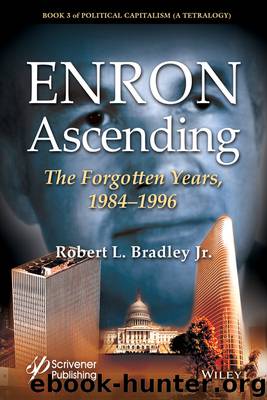Enron Ascending by Robert L. Bradley Jr

Author:Robert L. Bradley, Jr.
Language: eng
Format: epub
ISBN: 9781119494201
Publisher: Wiley
Published: 2018-08-30T14:21:00+00:00
Mark-to-market, the note concluded, was confined.
Enron’s other activities (which are accounted for on a lower of cost or market basis) also enter into forward, futures, and other contracts to minimize the impact of market fluctuations on inventories and other contractual commitments. Changes in the market value of those contracts entered into as hedges are deferred until the gain or loss is recognized on the hedged inventory or fixed commitment.
The changeover had taken about 18 months. First, Lay signed onto the concept as a condition of Skilling’s hiring. Skilling then persuaded his colleagues, and Enron’s audit committee approved in May 1991. Its chairman and lead decision maker was Dr. Robert Jaedicke, an accounting professor turned dean of Stanford Graduate School of Business.
Arthur Andersen, Enron’s outside auditor, was next, first with the Houston account team and then at Chicago headquarters. Enron’s outside counsel, Vinson & Elkins, and advisers from Bankers Trust (then a partner of EGS) were at the table. Final approval came in January 1992 from the Security and Exchange Commission (SEC) in Washington, DC.
There had been pushback. Early in the process, Enron’s David Woytek, a warning voice from the Valhalla oil-trading scandal a few years before, challenged Enron CFO Jack Tompkins about the liquidity of long-term gas contracts, which was needed for proper valuation. Mark-to-guess was not mark-to-market, Woytek argued, and thus income should not be realized in an accounting period unless money changed hands. Woytek also wondered about a growth wall, given that ever more deals were required for mark-to-market earnings growth.
Arthur Andersen had to get over the fact that oil and gas accounting had never been anything but accrual, with costs and revenues recorded as physically incurred. Not convincing its Houston office, Skilling presented to Andersen’s top brass in Chicago, which gave the okay so long as the SEC went along. And when the SEC declined to approve after due diligence, Skilling made a presentation at the SEC’s Washington headquarters to get the regulators to reverse. Letters followed, with Enron assuring regulators that its marks would be based on “known spreads and balanced positions” rather than being “significantly dependent on subjective elements.”
The SEC verdict came in a January 30, 1992, letter to Jack Tompkins approving mark-to-market for natural gas beginning that month. A new chief accountant, Walter P. Schuetze, had just taken over at the SEC, and he believed deeply in the logic of mark-to-market. Allowing Enron to employ the technique would be a step forward.
(Unfortunately, Schuetze had worked only for accounting firms and bureaucracies. He had never served on the staff of an industrial corporation, and his philosophy of mark-to-market accounting depended on the fantastic assumption that companies would call in neutral experts to do their mark-to-market estimates. Post-Enron, Schuetze testified that mark-to-market accounting required “competent, qualified, expert persons or entities that are not affiliated with, and do not have economic ties to, the reporting corporate entity.” The idea that Jeff Skilling would allow some outside, disinterested expert to come in and tell him what his assets were worth, regardless of what effect that might have on his numbers, was fanciful.
Download
This site does not store any files on its server. We only index and link to content provided by other sites. Please contact the content providers to delete copyright contents if any and email us, we'll remove relevant links or contents immediately.
Whiskies Galore by Ian Buxton(41940)
Introduction to Aircraft Design (Cambridge Aerospace Series) by John P. Fielding(33094)
Small Unmanned Fixed-wing Aircraft Design by Andrew J. Keane Andras Sobester James P. Scanlan & András Sóbester & James P. Scanlan(32766)
Craft Beer for the Homebrewer by Michael Agnew(18198)
Turbulence by E. J. Noyes(7980)
The Complete Stick Figure Physics Tutorials by Allen Sarah(7339)
Kaplan MCAT General Chemistry Review by Kaplan(6903)
The Thirst by Nesbo Jo(6881)
Bad Blood by John Carreyrou(6584)
Modelling of Convective Heat and Mass Transfer in Rotating Flows by Igor V. Shevchuk(6407)
Learning SQL by Alan Beaulieu(6239)
Weapons of Math Destruction by Cathy O'Neil(6219)
Man-made Catastrophes and Risk Information Concealment by Dmitry Chernov & Didier Sornette(5957)
Digital Minimalism by Cal Newport;(5706)
Life 3.0: Being Human in the Age of Artificial Intelligence by Tegmark Max(5518)
iGen by Jean M. Twenge(5387)
Secrets of Antigravity Propulsion: Tesla, UFOs, and Classified Aerospace Technology by Ph.D. Paul A. Laviolette(5335)
Design of Trajectory Optimization Approach for Space Maneuver Vehicle Skip Entry Problems by Runqi Chai & Al Savvaris & Antonios Tsourdos & Senchun Chai(5038)
Pale Blue Dot by Carl Sagan(4957)
